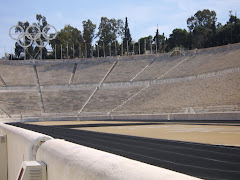
 When I was three years old, my parents placed two items in the upper terrace of our Oklahoma backyard.
When I was three years old, my parents placed two items in the upper terrace of our Oklahoma backyard. First, they planted a plum tree, which lasted only a few years in the crusty red dirt of the plains (I think we did harvest plums one or two years). Then my folks purchased and placed beside that tree a blue plastic kiddie pool -- likely from TG&Y -- which was a fun escape from the summer heat for my sister and I.
There are home movies of the youngster Wolavers splashing and spinning around to pretend to be Wonder Woman or other heroes of popular shows (both donning our swim trunks, made by mom, from fabric that matched Team USA's swimsuits worn at the Montreal Olympics of 1976, which was on TV during that summer in the pool).
The plum tree, plastic pool and Bruce Jenner on television -- these are my earliest Olympic memories, from age three.
Through a recent conversation, I enjoyed an introduction to Olympian Natalie Coughlin -- the swimming champion with 11 Olympic medals (so far) -- who shared via phone that she also got started in a pool in her parents' backyard.
"I was 10 months old, and we had a pool -- they taught me to swim, because it was a safety issue" said Coughlin, the recent celebrity judge on "Iron Chef America" and self-proclaimed foodie who now lends her voice to the California Dried Plum Board. "[And] I ate dried plums all the time."
Small world.
For those who are hungry, or plum lovers, or foodies, check out the plum good recipes Coughlin created for the Plum Board. My girlfriend and I may try to cook the meatball recipe soon (though making the salad may be more my speed).
During our phone conversation, I inquired how Coughlin made the transition from backyard swimmer to Olympian, and her first Olympic memories.
"In 1988 I was cheering on Janet [Evans]," who Coughlin mentioned she met for the first time only 12 years ago. "And during 1992 I was cheering for Summer Sanders and had a Speedo and shirt with 'It's Summer Time.'"
On meeting Sanders years later, Coughlin described the introductions as "a surreal thing."
It surprised me to learn that Coughlin got a start in broadcasting at the invitation of MSNBC for their 2006 Winter Olympic coverage, a footnote found in one of Coughlin's bios online. Coughlin explained she did contribute on air commentary and the Olympian's point of view during coverage for Torino, but the interviews were live from New Jersey rather than the Northern Italian host city.
When asked whether the experience was intended as a stepping stone to a broadcasting career (similar to Evans' and Sanders' post-Olympic endeavors), Coughlin said she "would love to do something in TV if the opportunity came along."
Though the "Iron Chef America" gig and "Dancing With The Stars" competition may be additional building blocks for on-air adventures, Coughlin made it clear her sights and focus are now on London 2012 and the competitions leading to next year's Games, including the upcoming world championships in Shanghai.
I asked whether she felt pressure to "three-peat" in her signature Olympic events, and whether her training focused on one stroke versus another.
"I'm training equally for the backstroke and the free," said Coughlin. "I can't just focus on one stroke. I will also continue on the butterfly and the breaststroke. It's more fun that way."
On the potential to "three-peat" at the 2012 Games, or bring home more medals, Coughlin said the pressure is different now than in 2004 or 2008.
"There was more pressure in Athens; more pressure to prove myself," said Coughlin. "Now there is less pressure. Now it feels like everything [i.e. medals in London] is icing on the cake."
Coughlin said she had been to London only once for less than 48 hours, and she looks forward to spending more time there. Of the future and prospects for an Olympic "four-peat" in Rio de Janiero in 2016, Coughlin said the focus only on the near future.
"It's way too soon to tell for Rio," said Coughlin. "I'm focused on the next year and a half."
Coughlin resides in the Bay Area of Northern California, so we also talked about San Francisco's Olympic connections including the Beijing-bound 2008 Olympic Torch Relay. Readers of this blog may recall the Mayor and other officials changed the relay path to minimize risk of anti-China protesters who lined the original route in equal numbers to Olympic fans.
"I was supposed to light the cauldron," said Coughlin, describing the ceremony that was to be the climax of the day's route through the city. "Instead, I carried the torch in the Presidio ... with Herschel Walker and [former San Francisco Mayor] Willie Brown.
"I still have the torch, and we're making a stand for it," said Coughlin.
Photo with plums via California Dried Plum Board
Photo at Beijing Olympics via Daylife.com and Getty Images
















